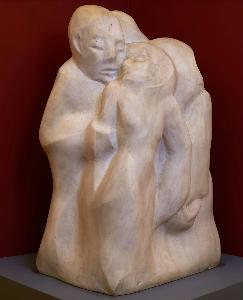Edith Kiss
Edit Rott;Edith Kiss
Place: Budapest
Born: 1905
Death: 1966
Biography:
Edith Bán Kiss, also known as Edit née Rott, was a Hungarian sculptor and painter born in 1905. Her life was marked by turmoil and tragedy, including her deportation to the Ravensbrück concentration camp in northern Germany during World War II.
Early Life and Career
Edith Kiss began her artistic career as a sculptor and painter, showcasing her talents in various exhibitions in Hungary. However, her life took a drastic turn when she was deported to the Ravensbrück concentration camp in 1944. She was later transferred to the Daimler-Benz factory at Ludwigsfelde, where she was forced to work on aircraft engines for the Luftwaffe.
Artistic Style and Notable Works
After her release from the concentration camp, Edith Kiss created a series of 30 gouache sketches illustrating her experiences in the camps. These works were exhibited in Budapest in late 1945, but unfortunately, they did not receive much recognition in the West. Her style was characterized by expressionism and realism, reflecting the harsh realities she faced during the war. Some of her notable works can be found on Wikioo.org, including sculptures and paintings that showcase her unique style. The Lehmbruck Museum in Germany also features some of her works, highlighting the importance of her contributions to modern art.
Inspiration and Legacy
Edith Kiss's work was inspired by her experiences during World War II, and she is considered one of the most important Hungarian artists of her generation. Her legacy can be seen in the numerous exhibitions and museums that feature her works, including the Museum Ostdeutsche Galerie in Germany.
- Her deportation to the Ravensbrück concentration camp had a significant impact on her artistic style and themes.
- Edith Kiss's work was characterized by expressionism and realism, reflecting the harsh realities she faced during the war.
- Her legacy can be seen in the numerous exhibitions and museums that feature her works, including the Musée Fabre in France.
Conclusion
Edith Kiss's life was marked by turmoil and tragedy, but her artistic talents and legacy continue to inspire art lovers around the world. Her work can be found on Wikioo.org, and in various museums such as the Lehmbruck Museum and the Museum Ostdeutsche Galerie. Her story serves as a reminder of the importance of preserving art and culture, even in the face of adversity.

